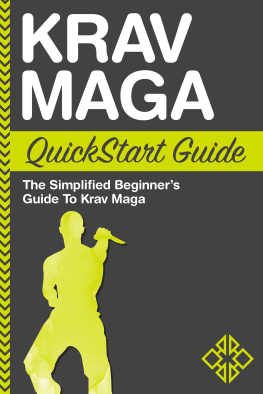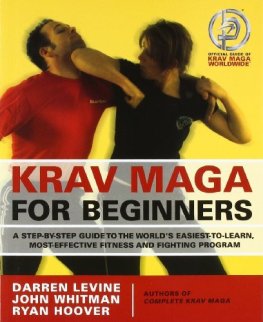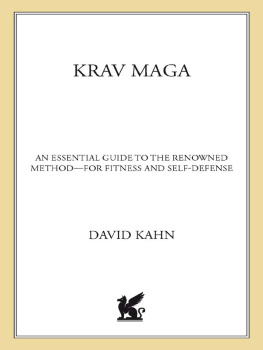Contents
Landmarks
Contents
Terms displayed in bold italic can be found defined in the glossary

BEFORE YOU START READING,
DOWNLOAD YOUR FREE DIGITAL ASSETS!
Visit the URL below to access your free Digital Asset files that are included with the purchase of this book.

DOWNLOAD YOURS HERE:
www.clydebankmedia.com/kravmaga-assets
Introduction
Krav Maga is an Israeli martial art born of necessity and brutal pragmatism. Its distinguishing characteristics include the continuous and synchronous combination of both offensive and defensive maneuvers, a no-holds-barred street fighting aesthetic, and a relatively easy learning curve that allows for quick and effective training. The systems fundamentals are extremely teachable, with new students learning highly effective techniques in a span of two to three lessons.
Some contend that the lack of ceremony found in Krav Maga warrants its reclassification from martial art to military combat system. Unlike other martial arts, there is little emphasis on style, Kata , or spirituality. Instead, Krav Maga emphasizes the quick and efficient neutralization of enemy threats as well as effective techniques to deploy against armed assailants. To support the change further, the Israeli Defense Forces and other professional security and military organizations have used it to quickly prepare personnel for the possibility of hand-to-hand combat. Like martial arts, an emphasis on conflict avoidance does permeate the teachings of Krav Maga in civilian training environments, but this seems mainly to punctuate how brutal and extravagantly violent Krav Maga tactics can be, a force so deadly, it should only be used as a last resort.
Several organizations within Israel and elsewhere teach Krav Maga, both to military, security, and civilian forces, including Krav Maga Global (KMG), the International Krav Maga Federation (IKMF), and International Krav Maga (IKM). Certain Krav Maga organizations led by highly renowned instructors operate only in Israel. These organizations include IKMA (Israeli Krav Maga Association), KMF (Krav Maga Federation), and Bukan. For serious Krav Maga students, journeying to Israel to commence study or to perfect ones skills is viewed as a rite of passage.
Most Krav Maga organizations use a grading system based on three main categories, P, G, and E, which stand respectively for Practitioner, Graduate, and Expert. Each category is divided into 5 ranks. The five Practitioner levels account for the majority of Krav Maga students worldwide. After mastering all of the essential techniques at the Practitioner level, students begin the five Graduate levels. A Graduate level ranking allows opens up the opportunity to become a Krav Maga instructor, though Graduates still need to pass a special instructors course in order to do so. In many of the Israeli clubs, ranking is displayed using a standard colored belt ranking system based on Judo. Other organizations use patches to delineate one rank from another. Lines on the patch represent each rank within a category. For example, this patch (figure 1) signifies a fourth level ranking in the Practitioner category or P4.

In order to qualify for Expert level ranking in Krav Maga, only those who prove themselves highly proficient in all Practitioner and Graduate level techniques and be outstanding overall fighters. Expert level Krav Maga instructors are most often chosen to teach military and security personnel. The highest ranking in Krav Maga is that of Master. Only a few people worldwide hold this title. A Master ranking essentially requires spending a lifetime developing expertise in Krav Maga and contributing significantly to the promotion and development of the Krav Maga fighting style.
As a disclaimer, its important for the aspiring Krav Maga fighter to understand what this book can and cannot provide. This book can provide sound insight into the fundamental principles and philosophy of Krav Maga. It can serve as a primer for training and givea significant advantage over individuals with no knowledge whatsoever about the Krav Maga fighting style. The book cannot train the fighter only a certified trainer can. None of the techniques illustrated and described in the book should be relied upon in a combat situation unless the situation is supervised and instructed by a graduate level Krav Maga fighter.
| 1 | History
The story of Krav Maga begins with the story of one man.










